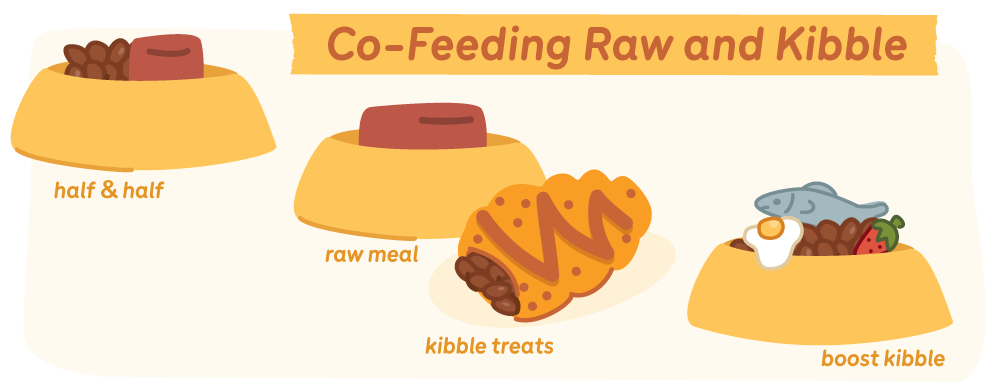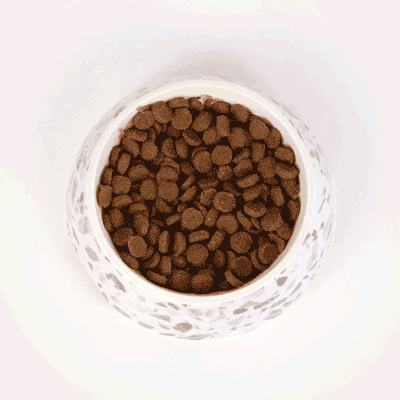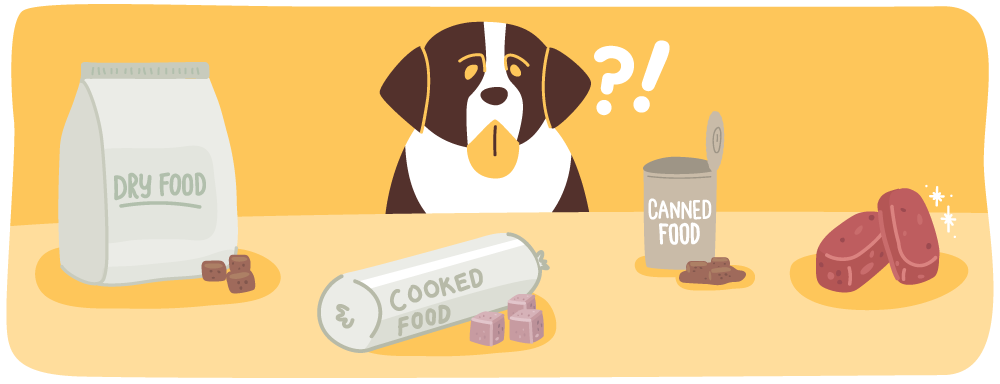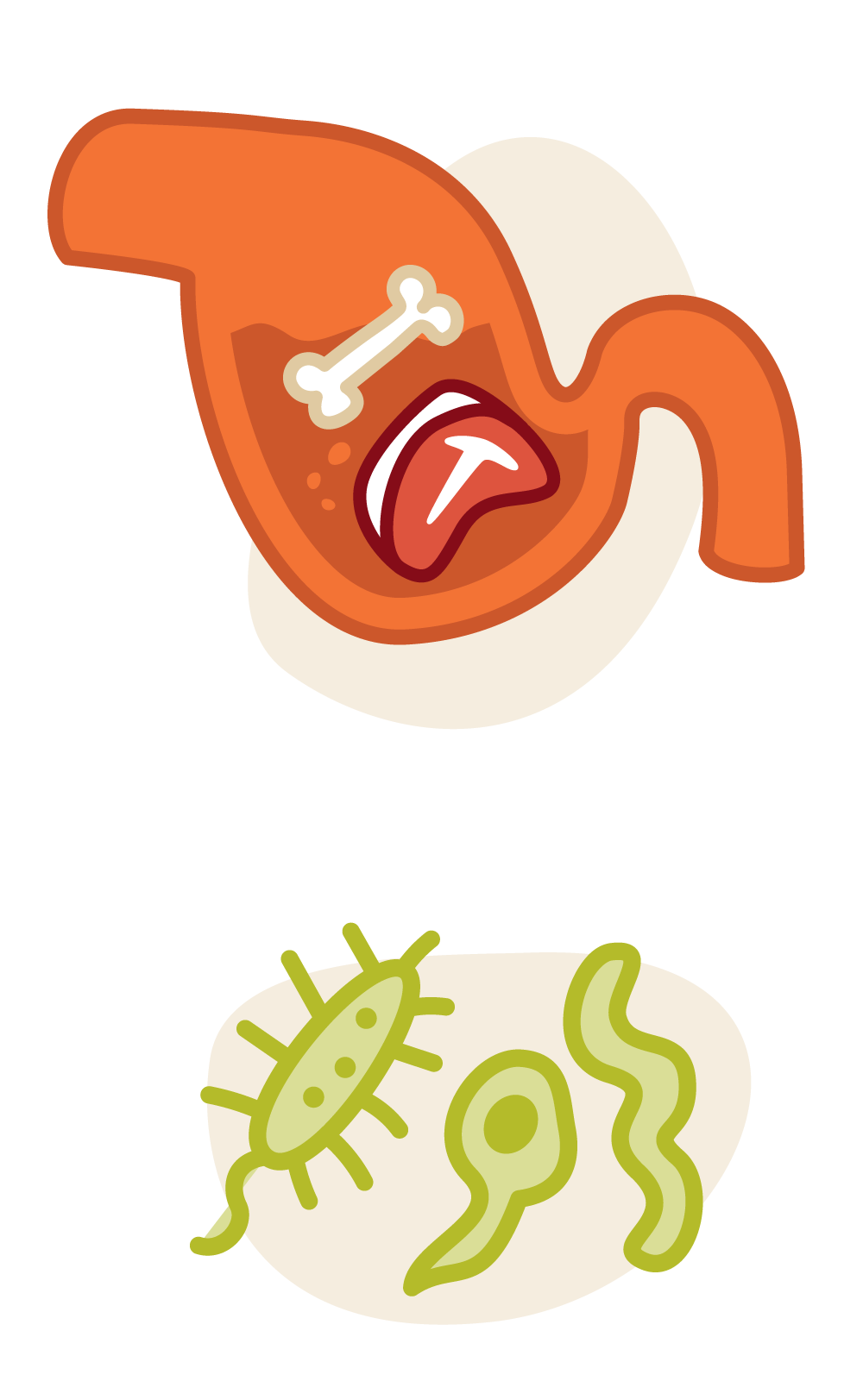Digestion rates, stomach acidity and co-feeding your pet

By Dr Duncan Houston, Veterinarian and Pet Nutritionist
Can you co-feed your pet with raw meat and kibble?
The simple answer is ‘Yes’ it’s possible according to the research available.
Let’s go through the research and information that’s available to show that even though this may not be the ideal dietary choice, it is a popular style of co-feeding for pets, and mixing processed foods with fresh foods is possible, even though many people claim it’s not.

The issue of gastric acid and mixing raw meat based diets (RMBD) with kibble is usually questioned when someone is transitioning from a processed diet to a fresh, raw food diet, and/or when they want to mix both diets. There are many reasons why someone may want to co-feed their pets, but in the past pet parents were told never to mix the two. Ideally, yes, I do prefer a fresh raw diet for utmost nutritional benefits, but in terms of stomach acid, enzymes and hormones for digestion there doesn’t seem to be a reason why not. In my opinion, as a veterinarian, any natural whole food added to a diet is better than none at all.
In the past, the main reason why people have said not to co-feed your pet with kibble and RMBD is due to stomach acidity. The most common opinions have been that kibble keeps the pH of a dog’s stomach too high so that bacteria won’t be killed and bone won’t digest properly, as well as the view that different foods digest at different rates. But this can all be confirmed as untrue.

Obviously, just suddenly mixing the two in large unknown amounts or switching straight from one to the other can set your animal up for a digestive disaster, but a slow transition over 10-14 days by incorporating a small amount of the new diet and building this up over time can help minimise digestive upsets. There are also prebiotic and probiotic supplements, like Big Dog’s probiotic, that can help support your pet through this transition period. There’s a comprehensive guide on introducing a new diet to your pet here.
There aren’t many studies comparing the digestion of raw vs. kibble diets but there is information available as to what can happen to nutrients with the different processes of manufacturing of these foods. Some of which show how raw diets are superior to synthetic kibble diets. Like everything, there are pros and cons, and also potential risks to both methods of feeding, but overall, it is best to view the long-term benefits opposed to potential immediate ones.

Manufacturing processes, such as cooking and extrusion, can affect nutrients in certain ways affecting digestibility, utilisation, microbiome, and immunity. We also need to consider all the nutrients within foods and whether anti-nutrients are present which can interfere with the body’s absorption of vitamins and minerals. Before I trail too far off topic, the discussion that we are delving into today is whether or not these manufacturing processes may affect digestion, if you’d like to read further about bioavailability and nutrition or the impact of processing on the nutrient content of pet foods, you can read the research here and here.
Stomach Acid and Digestive Enzymes

The stomach, and other organs, release enzymes and acids, mainly hydrochloric acid, to be able to digest the foods that are ingested as well as prevent harmful reactions. The pH refers to the acidity or alkalinity of this liquid and is a measure from 0 to 14, below 7 is acidic and above 7 is alkaline whereas 7 is deemed neutral. The degree of acidity affects the release of acids and enzymes involved in digestion. (https://www.worthington-biochem.com/introBiochem/effectspH.html)

The first step of digestion is during the anticipation of food, which is called the cephalic phase. Before any animal even ingests their food their saliva, stomach and pancreas have already started to release digestive enzymes, hormones and acids in preparation of it.
Digestive enzymes, amylase, lipase and protease, are released in the saliva and pancreas, but the enzymes released are in different amounts depending on the species, it varies mostly between carnivores, omnivores and herbivores. Amylase breaks down carbohydrates, Lipase breaks down fats and Protease breaks down proteins. Both dogs and cats do not secrete amylase in their saliva meaning they are similar to obligate carnivores and are less inclined to live off carbohydrates as a source of nutrition. Amylase and Lipase don’t work in strongly acidic environments, which means that the bulk of carbohydrate digestion occurs within the small intestine after these enzymes have been released by the pancreas. Another thing to note is that the pancreas of dogs produces more amylase than cats. This means that both dogs and cats have not evolved for carbohydrates to be a main source of nutrition (1,4).
When food enters the stomach, the hormone gastrin is released which controls the pH in the stomach by stimulating acid secretion. To counteract this and raise the pH, if needed, bicarbonate is produced as a buffer. The type of food being digested will change the amount of gastric acid and digestive enzymes released varying the stomach acid pH, with the average being stomach pH ranging between 1 and 3 during digestion (more acidic).

It’s not only these digestive enzymes, hormone gastrin and gastric acid that are produced in digestion. The stomach also secretes pepsinogen, trypsin and chymotrypsin to digest proteins and soften bone. So we know that when the stomach releases acid for digestion the pH drops. Now when the pH drops below 4 pepsinogen is converted to pepsin which breaks down proteins into their individual amino acids for absorption and utilisation by the body. The ideal stomach acid pH for this process is 2 to 3.5. Stomach acid pH levels of below 2.5 as well as the release of pepsin have been shown to reduce and inhibit harmful bacteria such as salmonella spp, clostridia, campylobacter and E coli. (1,4).
The stomach is a complicated yet smart organ varying the enzymes, hormones and pH based on what the food ingested is made of and how much there is to break down. After digestion the stomach receives signals to neutralise pH levels before the contents are released into the small intestine. This mix of food, enzymes, hormones and acids, called chyme, then leave the stomach and the pH begins to rise again in anticipation of another meal.
What about different rates of digestion?
Again, we don’t have many studies on the different rates of stomach emptying with dogs or cats eating a RMBD. So, the notion that kibble takes longer to digest is still a theory. Many factors affect the rate of digestion such as size, fat, moisture, shape and density. One small experiment using imaging techniques and a liquid to view gastric emptying, actually showed that bones did in fact take longer to digest than kibble when some people previously believed that kibble take longer to digest. Hence, we can’t conclude the results but in fact we can suppose that those theories around today are potentially false.
Can we know if raw and kibble diets differ in digestion?
It’s not easy to measure what is in the stomach after food is introduced, hence the limited number of studies. Unfortunately, this means there aren’t any studies comparing the pH of stomach acid between kibble fed versus RMBD fed animals. The current research is based on kibble or canned diets, which have higher carbohydrate contents, which measure the average pH to be around 1 to 3 (2,3).
What can we learn from the information available?
To sum everything up, the term ‘digestion confusion’ and the claims that raw and kibble cannot be mixed aren’t true when it comes to the information we have available on digestion, so far. There is still a lot more to discover due to the limited research available, and more to learn about digestion as well as the microbiome with animals fed different diets.
We know that both raw and kibble diets do result in an acidic environment within the stomach and that the pH is likely not much different. This means that both a dog’s and cat’s digestive system can break down mixed diets successfully, hence any animal fed kibble should at least include some fresh meat to supplement their diet if not wanting to go completely to a RMBD. Although with any change in diet there needs to be a transition period. Recent information shows that animals on kibble diets long term are at risk of pancreatitis if suddenly switched to high protein and fat diets, but those animals already on these high protein and fat diets are generally not at risk of pancreatitis if carbohydrates, such as kibble, are added.
As always please speak with a nutritional veterinarian or animal nutritionist to discuss the co-feeding options available and what is the ideal diet for your furry friend.
About the Author - Dr Duncan Houston, Veterinarian and Pet Nutritionist

Duncan is a Veterinarian and pet nutrition expert based in Sydney who works mainly as a mobile vet, but also in emergency and general practice. He has a passion for aquatics and nutrition, working with several natural pet food companies for over half a decade.
Triathlon and cycling were integral parts of Duncan’s life where he competed in several different countries taking home numerous achievements. He has always been active and maintains a healthy and exercise induced lifestyle, which he projects onto the animals he treats.
Duncan hopes he can provide you with up to date research and make it relevant to your pets at home. Better to be healthy now and get things right, such as nutrition early, as prevention is always better than cure.
References
1. Beasley, D., Koltz, A., Lambert, J., Fierer, N. and Dunn, R., 2015. The Evolution of Stomach Acidity and Its Relevance to the Human Microbiome. PLOS ONE, 10(7), p.e0134116.
2. Mahar, K., Portelli, S., Coatney, R. and Chen, E., 2012. Gastric pH and Gastric Residence Time in Fasted and Fed Conscious Beagle Dogs using the Bravo® pH System. Journal of Pharmaceutical Sciences, 101(7), pp.2439-2448.
3. Sagawa, K., Li, F., Liese, R. and Sutton, S., 2009. Fed and fasted gastric pH and gastric residence time in conscious beagle dogs. Journal of Pharmaceutical Sciences, 98(7), pp.2494-2500.
4. Zhu, H., Hart, C., Sales, D. and Roberts, N., 2006. Bacterial killing in gastric juice – effect of pH and pepsin on Escherichia coli and Helicobacter pylori. Journal of Medical Microbiology, 55(9), pp.1265-1270.
